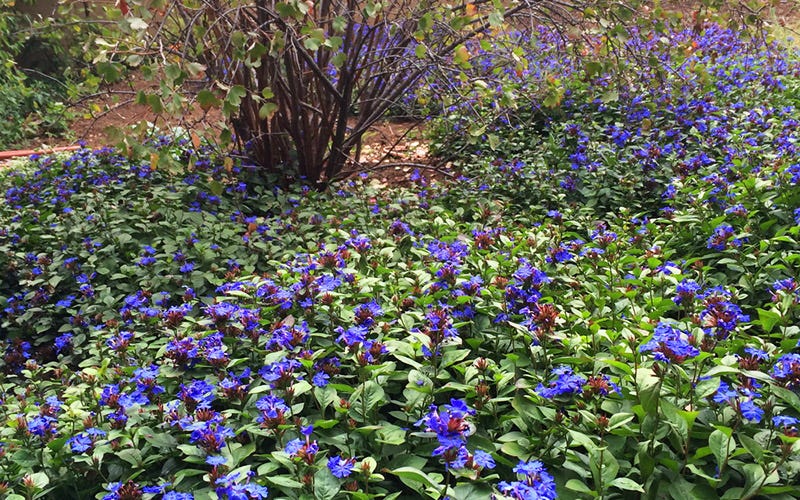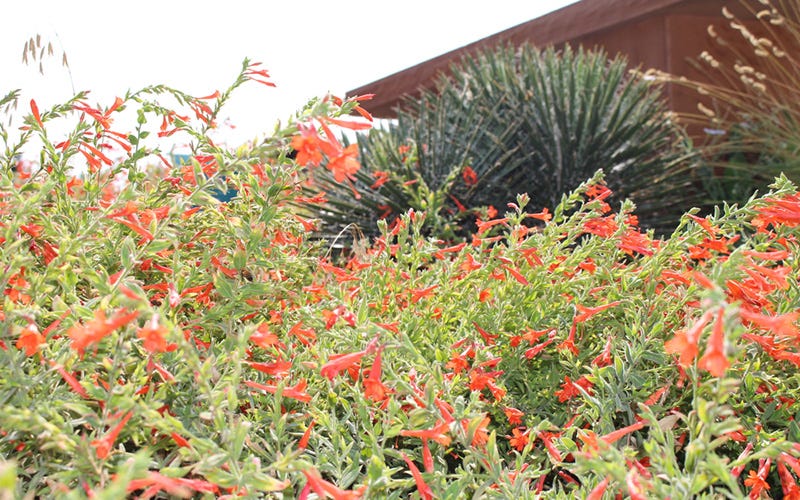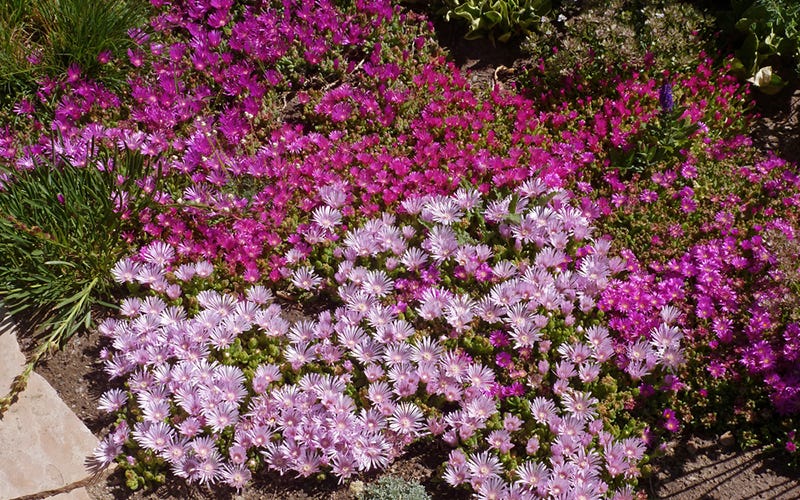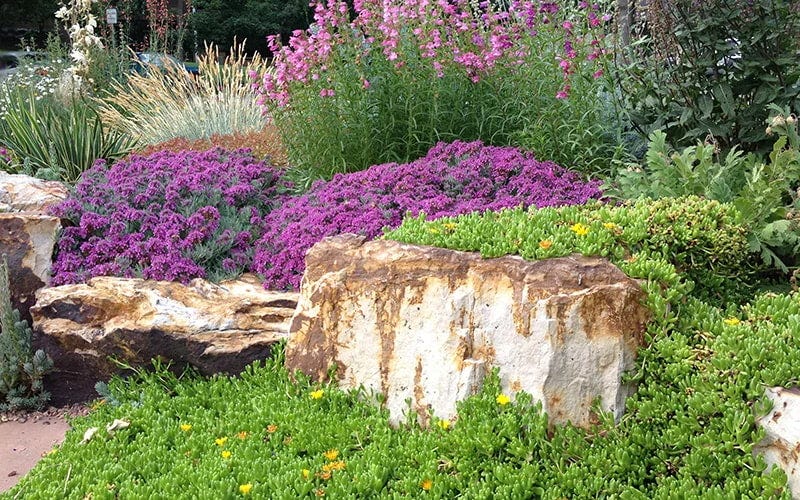By David Salman, Founder of High Country Gardens
Gardeners in the West, and across the country, are learning that you don’t need a lawn to have a beautiful yard. Replacing thirsty turf with waterwise plants will improve curb appeal and help support pollinators and birds while significantly saving water. Waterwise plants can use up to 70% less water than Kentucky Bluegrass! Read on to learn the perks of replacing your lawn with groundcovers, and see recommendations for quick-growing groundcovers and planting tips that will have your yard looking its best in no time.
Planting Groundcovers To Prevent A Heat Island Effect
Though it may seem like a quick solution - ripping out lawns and replacing them with bare patches of gravel or pavers is a short-sighted solution. Plants enhance, protect, and cool the soil. When lawns are removed and replaced only with gravel or pavers, it results in raising temperatures. Gravel and stone absorb heat, and on a large scale, this intensifies the urban “heat island” effect. As heat increases, we need to use more energy to cool our nearby living spaces. Use groundcovers instead of gravel to keep your yard cool - and colorful.
Planting A Pollinator-Friendly Lawn
One of the best benefits of replacing your lawn with perennial groundcovers is that you can offer habitat and natural nectar to pollinators. we gardeners take on the essential mission of protecting pollinator populations. Planting a mix of groundcovers with bloom times from spring through the fall will not only provide curb appeal, but also an ongoing supply of nectar for bees, butterflies, hummingbirds, and other beneficial insects. Even better, a healthy population of beneficial insects will help keep garden pests away.
Recommended Groundcovers For Lawn Replacement
The simplest way to replace your lawn is with perennial groundcovers. You can maintain the tidy, low-growing nature of a lawn, but with plants with much more benefit than traditional turf grass. There are numerous spreading groundcover plants that we can use to replace lawns. The really vigorous ones I like to call “galloping groundcovers” because they are fast growing and cover the ground quickly.
Some of my favorite fast-growing groundcovers include:
- Creeping Gold Buttons (Cotula sp. ‘Tiffendell Gold’) – a South African perennial that HCG introduced back in 2003. It’s deep-rooted, and the stems root as they spread, rapidly covering the ground with low, tight, bright evergreen foliage. The gold button-like flowers cover the plant in late spring for several months. Tolerates light foot traffic and sun/partial shade.
- Pink Soapwort (Saponaria ocymoides) – a spreading European wildflower that covers itself with a profusion of bright pink late spring flowers. The semi-evergreen foliage is attractive and deep green. For sun and partial shade areas.
- Sweet Woodruff (Gallium odoratum) – a shade lover that forms a dense, deep-rooted cover of attractive foliage. Blooming in late spring with a haze of small white flowers.
- Hardy Iceplant (Delosperma species and cultivars) – fast-growing and colorful, these evergreen South African groundcovers are just the thing for growing on top of and covering gravel. ‘Blut’ and Delosperma nubiginum are two of my favorites.
- Turkish Speedwell (Veronica liwanensis) – a stunning spring bloomer that covers itself with bright blue flowers. Best in cooler climates with adequate rain and snow to keep it watered.
- Carpeting Pincushion Flowers (Pterocephalus depressus) – a slower grower for small spaces, its evergreen foliage tolerates light foot traffic. The large mauve-pink flowers are showy and followed by feathery, ornamental seed heads. Tough and pretty. Best in sun.
- Creeping Hummingbird Trumpet (Zauschneria garrettii Orange Carpet®) – 2001 Plant Select Winner. This rapid-growing perennial spreads via underground stolons and forms a bright green carpet of foliage that disappears in late summer under a brushfire of brilliant orange flowers. Sun and partial shade.
- ‘Gold on Blue’ Prairie Zinnia (Zinnia grandiflora) – Plant Select 2014. A tough, long-lived, drought-tolerant native prairie wildflower that spreads by underground stolons that look like a blue-green shag rug. Blooms in summer with a profusion of golden daisies. Great for slopes. Thrives in full, blazing sun.
Don’t Sacrifice Our Shade Trees
Trees provide shade, cooling, habitat, and clean air, making them an important part of a healthy ecosystem - even in urban and suburban areas. As thirsty lawn grasses are removed, there is sometimes considerable collateral damage with the loss of tree canopy. Trees that have been planted into lawns may die from lack of water when gravel is spread and the lawn irrigation is abruptly shut off. If you have established trees in your yard, consider a plan to water these valuable ecological assets.
When Replacing Your Lawn, Bring Your Soil Back To Life
Old lawns are often growing on lifeless, compacted soil, damaged by many years of chemical fertilizers, herbicides, and insecticides. So bring life back into the soil before replanting is essential. When replacing a lawn with groundcovers, it’s important to loosen the soil and enrich it by mixing in compost, and soil amendments such as Mineral Boost and organic fertilizers like Yum Yum Mix to a depth of 12 inches.
Groundcover Planting Tips
When planting your new groundcovers, space the plants 12 to 18 inches apart. With good soil preparation and fast-growing groundcovers, you can expect to get full coverage quickly. Spread some corn gluten as a natural pre-emergent herbicide to prevent the germination of weed seeds between your groundcover starts. Water 2 to 3 times a week to get them established. By the second growing season, most groundcovers can get by with once-weekly watering, or less frequently, depending on the summer heat and rainfall. See our Groundcover Planting Guide for more details.







